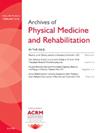Mapping the Challenges and Facilitators Faced by Orthotists, Physiotherapists, and Prosthetists to Integrating Non-3D Gait Evaluation Into Routine Practice: A Scoping Review of Key Concepts and Knowledge Gaps
IF 3.7
2区 医学
Q1 REHABILITATION
Archives of physical medicine and rehabilitation
Pub Date : 2025-10-01
DOI:10.1016/j.apmr.2025.03.042
引用次数: 0
Abstract
Objective
To systematically map the existing literature on the challenges and facilitators associated with integrating non-3D gait evaluation into routine clinical practice by orthotists, physiotherapists, and prosthetists across diverse settings and contexts, while identifying gaps in the evidence base related to these challenges and facilitators.
Data Sources
Following PRISMA-ScR guidelines, we searched databases from 1980 to December 2024 (CINAHL, OVID [including APA PSYCH], PEDRO, and WEB OF SCIENCE—ALL DATABASES [including MEDLINE]). We also carried out secondary searching through reference lists and Google Scholar.
Study Selection
Two authors separately screened 100 sources for calibration. One author screened the remaining sources and referred ambiguous sources to 2 others. Included sources studied challenges and facilitators to non-3D gait evaluation.
Data Extraction
Two authors developed and piloted an Excel data extraction form using 20 sources. Thereafter, one author extracted data, spot-checked by a second author.
Data Synthesis
We screened 11,641 sources, selecting 11 for inclusion. Ten focused solely on physiotherapy, one examined physiotherapy and prosthetics, and none addressed orthotics.
Conclusions
This scoping review examines challenges and facilitators to the adoption of non-3D gait evaluation methods in orthotics, physiotherapy, and prosthetics. Despite benefits, these methods are underused because of clinician awareness, confidence, experience, motivation, environmental constraints, resource limitations (eg, cost), and time pressures. Gait evaluation methods may also be difficult to use, unrealistic, or lack meaningful data. Clearer guidelines, targeted education, and health care provider support are essential. Improving the usability of gait evaluation methods and their integration into clinical practice is critical. Research gaps in prosthetics, orthotics, and specific gait evaluation methods highlight the need for further investigation to enhance training and inform policy adjustments, improving patient outcomes. Future research should investigate clinician perspectives on specific gait evaluation methods, such as video vector and standardized observational gait assessments, across specialties and their different specialisms.
映射挑战和面临的矫形师,物理治疗师和假肢整合非3d步态评估到常规实践的促进因素:关键概念和知识差距的范围审查。
目的系统地梳理现有文献,了解矫形师、理疗师和假肢安装师在不同环境和背景下将非三维步态评估纳入常规临床实践所面临的挑战和促进因素,同时找出与这些挑战和促进因素相关的证据基础中存在的差距:根据 PRISMA-ScR 指南,我们检索了 1980 年至 2024 年 12 月的数据库(CINAHL、OVID [包括 APA PSYCH]、PEDRO 和 WEB OF SCIENCE - ALL DATABASES [包括 MEDLINE])。我们还通过参考文献目录和谷歌学术进行了二次检索:两位作者分别筛选了 100 个来源进行校准。一位作者筛选了其余的资料来源,并将不明确的资料来源提交给另外两位作者。纳入的资料研究了非三维步态评估的挑战和促进因素:两位作者使用 20 个数据源开发并试用了 ExcelTM 数据提取表。之后,由一位作者提取数据,并由第二位作者抽查:我们筛选了 11,641 个资料来源,选择了 11 个纳入其中。其中 10 篇仅关注物理治疗,1 篇研究了物理治疗和假肢,没有一篇涉及矫形器:本范围综述探讨了在矫形、物理治疗和假肢治疗中采用非三维步态评估方法所面临的挑战和促进因素。尽管这些方法好处多多,但由于临床医生的意识、信心、经验、动机、环境限制、资源限制(如成本)和时间压力等原因,这些方法仍未得到充分利用。步态评估方法也可能难以使用、不切实际或缺乏有意义的数据。更明确的指南、有针对性的教育和医疗服务提供者的支持至关重要。提高步态评估方法的可用性并将其融入临床实践至关重要。假肢、矫形器和特定步态评估方法方面的研究空白凸显了进一步调查的必要性,以加强培训并为政策调整提供信息,从而改善患者的治疗效果。未来的研究应调查临床医生对特定步态评估方法的看法,如视频矢量和标准化观察步态评估,以及不同专科和不同专业的步态评估方法。
本文章由计算机程序翻译,如有差异,请以英文原文为准。
求助全文
约1分钟内获得全文
求助全文
来源期刊
CiteScore
6.20
自引率
4.70%
发文量
495
审稿时长
38 days
期刊介绍:
The Archives of Physical Medicine and Rehabilitation publishes original, peer-reviewed research and clinical reports on important trends and developments in physical medicine and rehabilitation and related fields. This international journal brings researchers and clinicians authoritative information on the therapeutic utilization of physical, behavioral and pharmaceutical agents in providing comprehensive care for individuals with chronic illness and disabilities.
Archives began publication in 1920, publishes monthly, and is the official journal of the American Congress of Rehabilitation Medicine. Its papers are cited more often than any other rehabilitation journal.

 求助内容:
求助内容: 应助结果提醒方式:
应助结果提醒方式:


